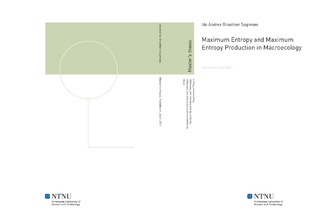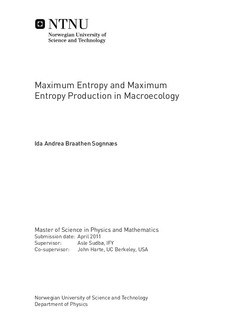| dc.contributor.advisor | Sudbø, Asle | nb_NO |
| dc.contributor.advisor | Harte, John | nb_NO |
| dc.contributor.author | Sognnæs, Ida Andrea Braathen | nb_NO |
| dc.date.accessioned | 2014-12-19T13:16:43Z | |
| dc.date.available | 2014-12-19T13:16:43Z | |
| dc.date.created | 2011-06-04 | nb_NO |
| dc.date.issued | 2011 | nb_NO |
| dc.identifier | 420740 | nb_NO |
| dc.identifier | ntnudaim:6568 | nb_NO |
| dc.identifier.uri | http://hdl.handle.net/11250/246406 | |
| dc.description.abstract | The Maximum Entropy Theory of Ecology (METE), developed by John Harte, presents an entirely new method of making inferences in ecology. The method is based on the established mathematical procedure of Maximum Information Entropy (MaxEnt), developed by Edwin T. Jaynes, and is used to derive a range of important relationships in macroecology. The Maximum Entropy Production (MEP) principle is a more recent theory. This principle was used by Paltridge to successfully predict the climate on Earth in 1975. It has been suggested that this principle can be used for predicting the evolution of ecosystems over time in the framework of METE. This idea is at the very frontier of Harte's theory. This thesis investigates the hypothesis that the information entropy defined in METE is described by the MEP principle.I show that the application of the MEP principle to the information entropy in METE leads to a range of conceptual and mathematical difficulties. I show that the initial hypothesis alone cannot predict the time rate of change, but that it does predict that the number of individual organisms and the total metabolic rate of an ecosystem will continue to grow indefinitely, whereas the number of species will approach one.I also conduct a thorough review of the MEP literature and discuss the possibility of an application of the MEP principle to METE based on analogies. I also study a proof of the MEP principle published by Dewar in 2003 and 2005 in order to investigate the possibility of an application based on first principles. I conclude that the MEP principle has a low probability of success if applied directly to the information entropy in METE.One of the most central relationships derived in METE is the expected number of species in a plot of area $A$. I conduct a numerical simulation in order to study the variance of the actual number of species in a collection of plots. I then suggest two methods to be used for comparison between predictions and observations in METE.I also conduct a numerical study of selectied stability properties of Paltridge's climate model and conclude that none of these can explain the observed MEP state in nature. | nb_NO |
| dc.language | eng | nb_NO |
| dc.publisher | Institutt for fysikk | nb_NO |
| dc.subject | ntnudaim:6568 | no_NO |
| dc.subject | MTFYMA fysikk og matematikk | no_NO |
| dc.subject | Teknisk fysikk | no_NO |
| dc.title | Maximum Entropy and Maximum Entropy Production in Macroecology | nb_NO |
| dc.type | Master thesis | nb_NO |
| dc.source.pagenumber | 114 | nb_NO |
| dc.contributor.department | Norges teknisk-naturvitenskapelige universitet, Fakultet for naturvitenskap og teknologi, Institutt for fysikk | nb_NO |

